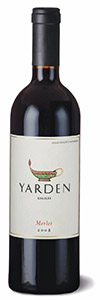
Families and friends gather each year for the Seder meal to retell the incredible story of Pesach. From beginning to end, the story of Pesach reminds us of the hardships the Jewish people endured as slaves in Egypt thousands of years ago, following their pathway to freedom.
To accompany the storytelling, bottles of wine sit on the Seder table for drinking the customary four glasses of wine, each glass representing the four expressions used by God in describing the Jews’ redemption.
When drinking the symbolic four glasses of wine, one may wonder about the origins of the wine in their glass, or the exodus of wine. A bottle of wine may be purchased easily in a local market, but the wine bottle’s journey to the aisle of that market is a long and extensive one. From picking a Merlot grape on a vine, to pouring the Golan Heights Winery Yarden Merlot wine in a crystal glass on the Seder table, the process of wine-making compares to the story of Pesach in a number of ways.
Looking closely at the winemaking process, grapes transform to wine in an elongated route of development and growth. During the harvest of the first stage, the winemaker must decide the precise time for picking the grapes. Before picking the grapes, the winemaker may consult with other winemakers or vineyard managers. Once they determine the grapes are ready, the winemaker picks the grapes.
As head winemaker of the Golan Heights Winery, Victor Schoenfeld oversees all winegrowing and wine production activities, and decides the appropriate time for picking the grapes. Furthermore, the areas where the grapes grow greatly impact the outcome of wines. The Yarden Blanc de Blancs, for example, is produced from fruits grown in one of the coldest regions of northern Israel, the Golan Heights. The wine makers must understand how regional temperatures impact the grapes before picking them. Schoenfeld’s critical role in the wine-making process very much compares to Moshe’s role in the story of freeing the Jewish people. Just as the fate of the grapes lay in the hands of the winemaker, the Jewish people left their fate in the hands Moshe after God instructed Moshe to redeem the Jews from Egypt.
Following the harvest, grapes move into the next period of the winemaking process: crushed and pressed. Thinking again to the story of Pesach, the Jews were also “crushed” and “pressed” in Egypt through their poor treatment and physical labor. With the help of God, it was up to Moshe to take the Jewish people out of slavery.
In the next stage of fermentation, the juices from the grapes naturally begin fermenting. Once the fermentation stage beings, the winemaker controls the amount of time the wine will ferment, which determines the sweetness or dryness of the wine. For example, the head wine maker of the Golan Heights Winery controls the fermentation of the Mount Hermon red wine, resulting in a dry wine. As people often refer to this stage the “magical” one, the story of Pesach contains many magical moments. For one, King Pharaoh’s daughter, Batya, miraculously found Moshe as a baby and raised him as her own. Moshe, thereafter, became a man of power in Egypt, a power to save the Jewish people when the time came.
Following fermentation, the wine maker uses his expertise to either immediately bottle the wine, or allow it to age further. The aging process allows the wine to grow and develop into its unique persona. Comparing these final stages to the story of Pesach, the Jewish people came after Moshe presented the ten tormenting plagues to the Egyptians, which resulted in King Pharaoh ordering Moshe to leave Egypt immediately with his Jewish people. Following their freedom, the Jewish people wandered the desert for 40 years, “clarifying” themselves as a nation, or growing and developing into the united nation God intended them to be.
The redemption of the Jewish people will forever be remembered year after year. Such a miraculous story teaches the Jewish nation the importance of its freedom and how far the nation has come today. During this commemoration, one must think of the wine in his glass with a sense of gratitude, for every glass of wine poured this holiday will have, also, undergone an extensive and tiring journey.
By Talia Zimmerman













